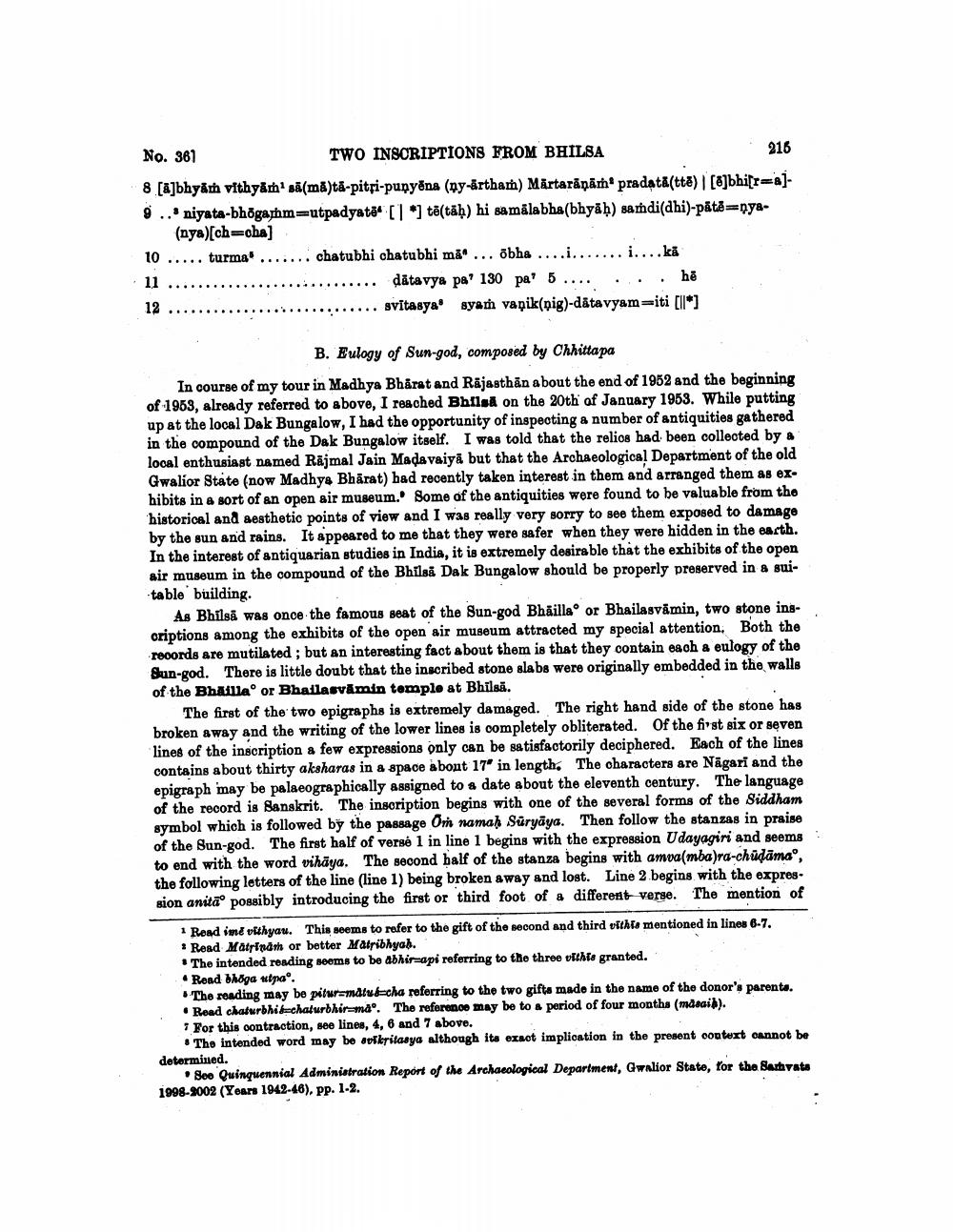________________
No. 361 TWO INSCRIPTIONS FROM BHILSA
216 8 []bhyam vithyam sā(mā)ta-pitri-punyềna (ny-ärtham) Märtarāņām pradətā(ttė) | Cajbhi[
ra]9... niyata-bhogamm=utpadyată[] *1 tē(tāḥ) hi samālabha(bhyāḥ) samdi(dhi)-päte=nya
(nya)(ch=cha] 10 ..... turma' ....... chatubhi chatubhi mã ... obha ............... kä
... dāta vya pa? 130 pa? 5.... .... hë .......... svītasya syam vaņik(pig)-data vyam=iti [ll]
B. Eulogy of Sun-god, composed by Chhittapa In course of my tour in Madhya Bharat and Rājasthan about the end of 1952 and the beginning of 1963, already referred to above, I reached Bhilsa on the 20th of January 1953. While putting up at the local Dak Bungalow, I had the opportunity of inspecting a number of antiquities gathered in the compound of the Dak Bungalow itself. I was told that the relios had been collected by a local enthusiast named Rajmal Jain Madavaiya but that the Archaeological Department of the old Gwalior State (now Madhya Bharat) had recently taken interest in them and arranged them as ex. hibits in a sort of an open air museum. Some of the antiquities were found to be valuable from the historical and aesthetic points of view and I was really very sorry to see them exposed to damage by the sun and rains. It appeared to me that they were safer when they were hidden in the earth. In the interest of antiquarian studies in India, it is extremely desirable that the exhibits of the open sir museum in the compound of the Bhilsă Dak Bungalow should be properly preserved in a suitable building.
As Bhilsă was once the famous seat of the Sun-god Bhailla or Bhailasvāmin, two stone ingcriptions among the exhibits of the open air museum attracted my special attention. Both the records are mutilated; but an interesting fact about them is that they contain each a eulogy of the Sun-god. There is little doubt that the inscribed stone slabs were originally embedded in the walls of the Bhalla or Bhallasvāmin templo at Bhilsa.
The first of the two epigraphs is extremely damaged. The right hand side of the stone has broken away and the writing of the lower lines is completely obliterated. Of the first six or seven lines of the inscription a few expressions only can be satisfactorily deciphered. Each of the lines contains about thirty aksharas in a space abont 17" in length. The characters are Nāgari and the epigraph may be palaeographically assigned to a date about the eleventh century. The language of the record is Sanskrit. The inscription begins with one of the several forms of the Siddham symbol which is followed by the passage om namah Suryāya. Then follow the stanzas in praise of the Sun-god. The first half of versé 1 in line 1 begins with the expression Udayagiri and seems to end with the word vihāya. The second half of the stanza begins with amva(mba)ra-chudāma", the following lotters of the line (line 1) being broken away and lost. Line 2 begins with the expression anitao possibly introducing the first or third foot of a different verse. The mention of
1 Read iné vithyau. This seems to refer to the gift of the second and third vithio mentioned in lines 6-7. . Read Mätrinam or better Matribhyah.
The intended reading seems to be abhir-api referring to the three uithio granted. • Road bhoga utpao.
The reading may be pitur-matutucha referring to the two gifts made in the name of the donor's parents. • Read chaturbhik chaturbhir=mao. The reference may be to a period of four months (mdaaih). 1 For this contraction, see lines, 4, 6 and 7 above.
• The intended word may be solkritasya although its exact implication in the present context cannot be determined.
.800 Quinquennial Administration Report of the Archaeological Department, Gwalior State, for the Sattyata 1998-2002 (Years 1942-46), pp. 1-2.




